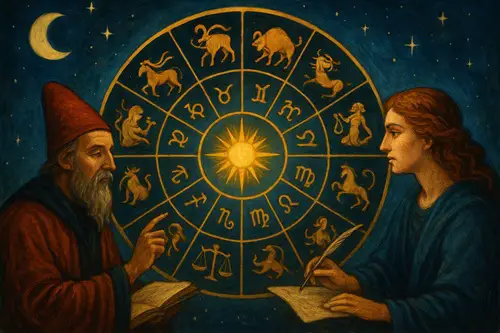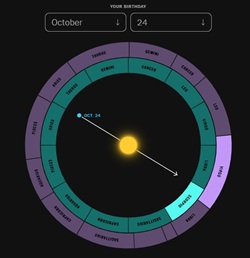|
TRANSLATE THIS ARTICLE
Integral World: Exploring Theories of Everything
An independent forum for a critical discussion of the integral philosophy of Ken Wilber
  Frank Visser, graduated as a psychologist of culture and religion, founded IntegralWorld in 1997. He worked as production manager for various publishing houses and as service manager for various internet companies and lives in Amsterdam. Books: Ken Wilber: Thought as Passion (SUNY, 2003), and The Corona Conspiracy: Combatting Disinformation about the Coronavirus (Kindle, 2020). Frank Visser, graduated as a psychologist of culture and religion, founded IntegralWorld in 1997. He worked as production manager for various publishing houses and as service manager for various internet companies and lives in Amsterdam. Books: Ken Wilber: Thought as Passion (SUNY, 2003), and The Corona Conspiracy: Combatting Disinformation about the Coronavirus (Kindle, 2020).
DEBUNKING ASTROLOGY:
Synchronicity As the Last Defense of Astrology The Mythic Rehabilitation of Astrology The Death Blow to Astrology
Check out my other conversations with ChatGPT The Death Blow to AstrologyThe Problem of PrecessionFrank Visser / ChatGPT
 For centuries, millions have checked their horoscopes to see what the stars have in store for them—confident, perhaps, that as an Aries they are fiery and assertive, or as a Pisces, sensitive and dreamy. But here's the cosmic joke: thanks to a slow wobble in Earth's rotation, almost all of us have been looking at the wrong sign for over two thousand years. The Sun no longer appears in Aries when astrology says it does. It's actually in Pisces. And that simple astronomical fact, known as the precession of the equinoxes, is fatal to the entire system of sun sign astrology.[1] Let's unpack this celestial embarrassment—and the creative rationalizations that have tried, and failed, to save astrology from it. The Astronomical Fact No Astrologer Can Wish AwayThe Earth spins on its axis like a top, but it also wobbles slowly, completing one full precessional cycle every 26,000 years. This means that the point where the Sun crosses the celestial equator in spring—the “vernal equinox,” which ancient astrologers took as the start of Aries—drifts backward through the zodiac at about one degree every 72 years. When the system of Western astrology was codified in Babylonian and later Hellenistic times (around 2000–500 BCE), the first day of spring indeed occurred when the Sun entered the constellation Aries. But today, thanks to precession, that same point lies in Pisces—and is drifting toward Aquarius. In other words, when your horoscope says you're an Aries, the Sun was actually in Pisces when you were born. If astrology is supposed to map celestial influences, then all of its coordinates are off by an entire constellation. It's as if meteorologists used a weather map from 2000 years ago and still claimed it was accurate. The “Tropical” Escape Hatch: Astrology Redefined as SymbolicFaced with this disaster, astrologers have not conceded defeat. Instead, they've performed an impressive feat of intellectual gymnastics: they've changed the meaning of the zodiac itself. Modern Western astrologers claim that the signs of the zodiac no longer refer to the constellations—the actual star patterns in the sky—but to seasonal segments of the Earth's orbit around the Sun. The zodiac, they argue, is a symbolic division of the ecliptic into twelve equal 30°sectors, starting at the spring equinox. Aries, they say, doesn't mean “the constellation of the Ram” anymore; it means “the first 30°after the equinox.” This is known as the tropical zodiac, as opposed to the sidereal zodiac still used in Indian (Vedic) astrology, which attempts to track the constellations more literally. By redefining Aries as “that which begins at the spring point,” astrologers hope to preserve their art against astronomical drift. But notice what they've done: they've abandoned the stars themselves, the very objects whose supposed influence gave astrology its name. “Star logic” has been replaced by calendar symbolism. Astrology, once a claim about celestial causation, has become an elaborate system of seasonal poetry. Rationalization #1: “It's About Symbolism, Not Astronomy”When challenged, many astrologers now respond that astrology isn't meant to reflect physical space—it's a psychological language of archetypes. The stars are merely mirrors for inner realities. Precession doesn't matter because astrology operates on a symbolic resonance, not a material one. This position conveniently immunizes astrology from empirical disproof. But it also drains it of explanatory power. If the zodiac doesn't correspond to the heavens, why use planets or constellations at all? Why not base horoscopes on the positions of clouds, or coffee stains, or tea leaves? At least those would be honestly symbolic. Rationalization #2: “The Tropical Zodiac Reflects Earthly Seasons”Some astrologers argue that the tropical zodiac remains valid because it's tied to the Earth's seasonal cycle—Aries marking spring's vigor, Cancer the fertility of summer, Libra the balance of autumn, and Capricorn the chill of winter. But this “seasonal symbolism” is Northern Hemisphere–centric. Below the equator, the seasons are reversed: Aries season in the north corresponds to autumn in the south. Yet Australian or South African astrologers still assign the same fiery, springlike qualities to Aries, even though it's literally fall outside. So much for being attuned to nature's rhythms. This argument exposes astrology's cultural parochialism: it was invented for Mediterranean farmers and has never adapted to global reality. Rationalization #3: “The Signs Are Archetypes, Not Star Maps”A more Jungian defense says that Aries, Taurus, and the rest are psychological archetypes, timeless expressions of human experience that somehow “resonate” with cosmic cycles. But that's an evasion, not an explanation. Archetypes may be real features of the psyche, but their attachment to arbitrary segments of the sky has no justification beyond historical accident. If Aries energy means initiative and new beginnings, that's fine—but what makes that specific 30°of sky more initiatory than the next? Astrology never answers this. It simply recycles its own metaphors. Rationalization #4: “Both Zodiacs Work!”Some astrologers, unwilling to choose between the tropical and sidereal systems, claim that both are “true on different levels.” Western astrology is said to map the soul, while Vedic astrology maps the karma or fate. But this is a classic case of cognitive dissonance management: when two contradictory systems both claim success, believers invent a mystical hierarchy rather than admit that one—or both—are wrong. If two incompatible coordinate systems can both yield “accurate readings,” that only proves how elastic and self-confirming the practice has become. The Emperor's New StarsThe precession problem exposes astrology's fatal flaw: it cannot decide whether it is a science of the heavens or a psychology of symbols. The first claim is falsified by astronomy; the second dissolves into metaphor. Either way, the celestial coordinates on which horoscopes are based have long since drifted out of alignment with the actual sky. In truth, astrology survives not because it's true, but because it's meaningful. It offers narrative order, poetic resonance, and emotional comfort in a chaotic universe. But meaning is not evidence, and myth is not measurement. The stars haven't changed—but our understanding of the cosmos has. And once you grasp that your “sign” no longer matches your sky, the spell is broken. The constellations go on shining, indifferent to our projections. The death blow was struck long ago—only belief, like an afterimage, still lingers in the dark. Addendum: The Sidereal Countermove – “We Have the Real Zodiac!”Not all astrologers have retreated into symbolism. In India, a proud and ancient astrological tradition—Jyotish, or Vedic astrology—has long recognized the problem of precession and sought to correct for it. These astrologers use what's called the sidereal zodiac, which attempts to anchor the twelve signs to the actual constellations rather than to the shifting seasonal points of the Earth's orbit. Each year, sidereal astrologers adjust their calculations by a small offset, known as the ayana?sa, to account for the slow backward drift of the equinox. By doing this, they claim to preserve the true astronomical relationship between the heavens and human fate. “Western astrology is symbolic,” they say, “but ours is real.” However, this defense only trades one problem for another. The constellations themselves are arbitrary visual groupings of stars at wildly different distances, joined only by the imagination of ancient sky-watchers. Their boundaries were officially fixed by the International Astronomical Union in 1930—long after astrology began—meaning that any supposed “natural” correspondence between constellations and human character is a modern bureaucratic fiction. Worse, the constellations aren't even twelve. The Sun passes through thirteen of them, including Ophiuchus, the serpent bearer, which modern astrologers conveniently ignore because it spoils the symmetry. So even the sidereal system, which boasts of being astronomically grounded, relies on a simplified and historically outdated map of the heavens. In the end, both camps—the tropical symbolists and the sidereal literalists—are trying to patch a leaky vessel. One denies the stars; the other romanticizes them. Both rest on a premise that the universe is somehow arranged for human storytelling. Precession is thus not just an astronomical curiosity—it's astrology's reckoning with reality. The sky has moved on, but the horoscope has not. And that, more than anything, reveals the enduring human tendency to prefer ancient patterns to uncomfortable truths. NOTES[1] See this New York Times article for explanation, and a tool with which you can find out what your "real" sun sign is: "Your Zodiac Sign Is 2,000 Years Out of Date", Sept. 7, 2025.
 Comment Form is loading comments...
|